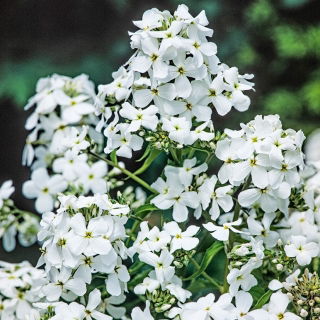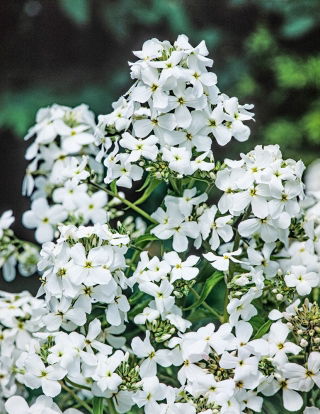Dame's Rocket, known scientifically as Hesperis matronalis, is a charming perennial plant that is sure to capture attention with its beauty and delicate fragrance. Its white flowers, gathered in loose clusters, add elegance to any garden and are also excellent as cut flowers for vases. Dame's Rocket reaches a height of 50 to 100 cm, making it an ideal choice for perennial borders. It is also a honey-bearing plant that attracts bees and other pollinators, thus supporting biodiversity in the garden.
Sowing
Dame's Rocket is best sown directly into the ground. The seeds require suitable conditions to ensure healthy development. It is recommended to carefully prepare the soil, remove weeds, and loosen it. To provide the seeds with the best conditions for germination, ensure the soil maintains moderate moisture.
Sowing Depth
The seeds of Dame's Rocket should be placed at a depth of about 1 cm. This depth protects the seeds from drying out and allows the sprouts to easily break through to the soil surface. It is important to gently firm the soil after sowing to ensure good contact between the seeds and the substrate.
Direct Sowing Period
When should you sow Dame's Rocket seeds directly into the ground? The optimal sowing period is from April to May. During this time, the soil is sufficiently warmed, promoting rapid germination. It is crucial to avoid frosts that can damage young seedlings.
Plant Spacing
Dame's Rocket thrives best when spaced 50x70 cm apart. This arrangement provides the plants with enough space for growth and development, promoting healthy shoot development and abundant flowering. It also ensures better air circulation, minimizing the risk of diseases.
Site Conditions
Dame's Rocket prefers sunny or slightly shaded locations where the soil is fertile, well-drained, and moderately moist. This plant adapts well to various conditions but blooms best in nutrient-rich soils. Regular watering during dry periods will ensure healthy growth and abundant flowering.
Growing Tips
Growing Dame's Rocket is not demanding, but it is worth remembering a few basic principles. Regular removal of faded flowers encourages the plant to continue blooming longer. It is also essential to weed the soil around the plant to prevent competition for water and nutrients. In spring, organic fertilization can be applied to support the plant as it begins a new growing season.
Plant Height
Dame's Rocket reaches a height of 50 to 100 cm, making it an ideal choice for the background of perennial borders. Its slender, upright stems add elegance and structure to any garden.
Flowering Period
Dame's Rocket blooms from May to June, offering an abundance of white flowers that fill the garden with a pleasant scent. With its long flowering period, this plant is an excellent choice for those wishing to enjoy nature's beauty for many weeks.
Usage
Dame's Rocket is a versatile plant that works well in perennial borders, naturalistic gardens, and as a cut flower. Its delicate fragrance and attractive appearance also make it an ideal choice for scented gardens. Being a honey-bearing plant, it attracts pollinators, making it a valuable component of the garden ecosystem.
Resistance to Diseases
Dame's Rocket is characterised by good resistance to most diseases, making it an easy-to-grow choice for any gardener. However, it is advisable to monitor the plant for potential pests and take preventive measures if necessary.
Why Buy from Garden Seeds Market
Garden Seeds Market guarantees the highest quality seeds that have undergone rigorous laboratory testing to ensure their germination effectiveness. Customers can rely on fast and secure deliveries, as well as professional service and expert advice. The range includes only premium seeds that will meet the expectations of even the most demanding gardeners. Numerous positive reviews from satisfied customers confirm the reliability of the store, which has enjoyed the trust of plant enthusiasts for years.
The package contains 1 g of seeds. The packaging includes information on growing instructions and the shelf life of the seeds.






